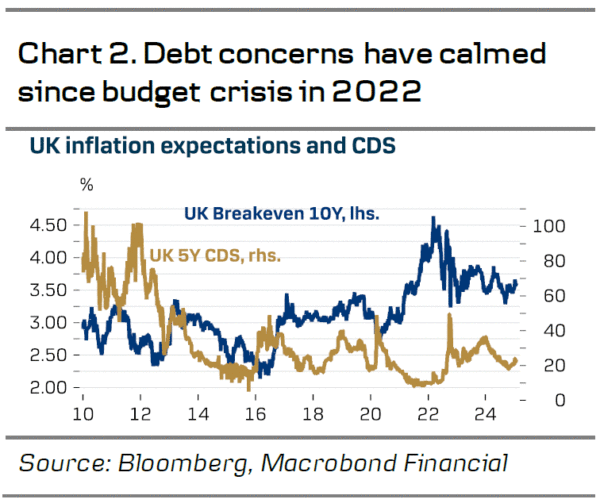- GBP is left vulnerable given the UK’s fragile position with a high public debt, public deficit and current account deficit.
- BoE preview – we expect the BoE to reiterate the message of a favouring gradual approach to the cutting cycle (page 2).
- We are strategically bearish on EUR/GBP; we recommend fading debt concern related rallies. Balance of risk on Thursday’s BoE meeting is for a weaker GBP.
When Chancellor Reeves presented her latest full budget accompanied by a report from the independent fiscal watchdog OBR end October 2024, she was left a historically slender headroom of GBP 9.9bn for meeting her fiscal objective. She presented an expansionary budget, which focused on increasing public investments and while partly funded by tax rises, the majority is set to be funded by increasing borrowing. As we have previously argued, we think the government is set to either roll back some of its measures or hike tax rates further at the next fiscal event in March.
With the recent rise in long-end Gilt yields and growth coming in weaker than expected by the OBR, this headroom is most likely gone, shedding a new light on the unsustainability of public finances. The combination of high interest rates, muted growth expectations and a primary deficit leaves a tricky backdrop for the UK as growth does not act as an aiding force (chart 1). Additionally, this is currently set to leave the UK unable to run with a deficit on its public finances without increasing the debt already running at close to 100% of GDP.
Hence, the fragile fiscal position combined with conducting an expansionary fiscal policy leaves the UK vulnerable to the global backdrop. Especially when we see a substantial tightening of global financial conditions, a sharp move higher in global rates combined with historically elevated levels in global long-end yields. This is further amplified in an environment characterised by a sharp sell-off in risk where liquidity becomes scarce since the UK runs a large current-account deficit, which makes GBP vulnerable whenever capital inflows fade. This scenario materialised at the beginning of the year where Gilt yields rose sharply and GBP weakened substantially.
Going forward, we expect the Labour government to either roll back some of its expansionary measures, cut spending further or hike taxes in the statement presented on 26 March to meet the budget rules. Additionally, the BoE earlier this week introduced the Contingent Non-Bank Financial Institution Repo Facility (CNRF) which will lend to NBFIs during episodes of “severe gilt market dysfunction” to help maintain financial stability. While the fragile fiscal backdrop leaves GBP susceptible to a sell-off every time focus turns to fiscal sustainability or we see a sharp sell-off in risk and long-end yields rise notably, we ultimately think this will fade, as seen most recently. We continue to be bullish on GBP as we think a relatively hawkish BoE, and a growth pickup in the UK relative to the euro area in 2025 will weigh on the cross in the coming quarters. This is further amplified by continued tight credit spreads and a return to the positive GBP-USD correlation in a USD positive investment environment.
BoE preview: a gradual rate cutting cycle remains base case
We expect the Bank of England to cut the Bank Rate by 25bp to 4.50% on Thursday 6 February in line with consensus and market pricing. We expect the vote split to be 8-1 with the majority voting for a cut and hawk Catherine Mann voting for an unchanged decision. Note, this meeting will include updated projections and a press conference following the release of the statement.
Overall, we expect the BoE to stick to its previous guidance noting that “a gradual approach to removing monetary policy restraint remains appropriate”. Since the last monetary policy decision in December, the economy has stagnated, the labour market has continued its gradual loosening while price pressures continue to be elevated. The economy ended 2024 on a weak note and the preliminary PMI data for January indicates that growth remains muted, increasing the downside risks to the growth outlook. We expect the BoE to revise growth downwards across the forecast horizon and believe the more muted growth outlook opens the door for a slight dovish twist to the BoE’s communication.
In the labour market, while conditions continue to ease with vacancies edging lower and unemployment coming in higher than the BoE expected in November, wage growth continues to spell trouble. In the private sector regular wage growth rose to 6.0% in the three months to November, set to overshoot the BoE’s Q4 forecast of 5.1%. This is likely to concern the hawkish camp of the MPC.
On the inflation front, service inflation has surprised to the downside relative to the MPC’s November expectation, dropping to 4.4% with momentum also showing signs easing. The latest PMI report for January however revealed that both input and output price pressures remain not only elevated but are gaining momentum. We expect the BoE to lift the inflation forecast in the near-term and pencil in a slight undershoot of the 2% target further out given that the more hawkish implied Bank Rate conditioning path.
BoE call. We expect the BoE to stick to quarterly cuts, leaving the Bank Rate at 3.75% by YE 2025, which is lower than markets are expecting. Markets are pricing around 75bp for 2025. However, we highlight that the risk is skewed towards a swifter cutting cycle in 2025, given the clearly dovish bias within the MPC as evident from the December meeting.
Market reaction. We expect the market reaction to be rather muted upon announcement with a cut fully expected by markets. On balance, we tilt towards a dovish twist during the press conference with downside risks to growth tentatively materialising. This could suggest some slight EUR/GBP topside and lower UK rates following the release of the statement. More broadly, we expect EUR/GBP to move lower in the coming quarters driven by a relatively hawkish BoE, and a growth pickup in the UK relative to the euro area in 2025. The key risks are reignited debt concerns and a more forceful policy easing stance from the BoE.
















